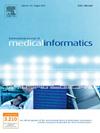Utilization, challenges, and training needs of digital health technologies: Perspectives from healthcare professionals
IF 3.7
2区 医学
Q2 COMPUTER SCIENCE, INFORMATION SYSTEMS
International Journal of Medical Informatics
Pub Date : 2025-02-11
DOI:10.1016/j.ijmedinf.2025.105833
引用次数: 0
Abstract
Introduction: Digital health technology (DHTs), such as electronic health records (EHRs), mobile health apps, and remote monitoring systems, is revolutionizing contemporary healthcare by improving diagnosis, patient care, and operational efficiency. Notwithstanding these developments, infrastructure, technical assistance, and personnel training remain obstacles to the successful deployment of DHTs.
Methods: 500 medical experts participated in a survey to evaluate the use, advantages, and challenges of DHTs. The frequency of DHT use, the perceived advantages, and the challenges—such as technical difficulties and a lack of training—were the main topics of the data gathered.
Results: The most popular technology was mobile health apps (44.4%), followed by EHR systems and diagnostic tools (33.3%). Benefits reported included decreased administrative burden (50%) and increased diagnostic accuracy (46.2%). However, there significant obstacles were found, though: 63% of respondents said they had only received limited training, and 51.9% mentioned software bugs and network problems. Despite these obstacles, 63% of those surveyed reported increases in the effectiveness of healthcare delivery.
Discussion: Our study finds a gap between the infrastructure needed for DHTs to be implemented successfully and their quick adoption. This study challenges the notion that adopting technology alone increases productivity by highlighting the importance of thorough technical assistance and staff training. These issues need to be resolved if DHTs are to be fully utilized for improved healthcare delivery and operational effectiveness.
数字卫生技术的利用、挑战和培训需求:来自医疗保健专业人员的观点
数字医疗技术(dht),如电子健康记录(EHRs)、移动医疗应用程序和远程监控系统,通过改善诊断、患者护理和运营效率,正在彻底改变当代医疗保健。尽管有这些发展,基础设施、技术援助和人员培训仍然是成功部署dht的障碍。方法:500名医学专家参与调查,对dht的使用、优势和挑战进行评价。DHT使用的频率、感知到的优势和挑战——如技术困难和缺乏培训——是收集数据的主要主题。结果:最受欢迎的技术是移动健康应用程序(44.4%),其次是电子病历系统和诊断工具(33.3%)。报告的益处包括减少行政负担(50%)和提高诊断准确性(46.2%)。然而,也发现了重大障碍:63%的受访者表示他们只接受过有限的培训,51.9%的受访者提到了软件漏洞和网络问题。尽管存在这些障碍,63%的受访者报告说,医疗保健服务的有效性有所提高。讨论:我们的研究发现,成功实施dht所需的基础设施与迅速采用dht之间存在差距。这项研究通过强调彻底的技术援助和工作人员培训的重要性,挑战了单独采用技术可以提高生产力的观念。如果要充分利用dht改善医疗保健服务和业务效率,就必须解决这些问题。
本文章由计算机程序翻译,如有差异,请以英文原文为准。
求助全文
约1分钟内获得全文
求助全文
来源期刊

International Journal of Medical Informatics
医学-计算机:信息系统
CiteScore
8.90
自引率
4.10%
发文量
217
审稿时长
42 days
期刊介绍:
International Journal of Medical Informatics provides an international medium for dissemination of original results and interpretative reviews concerning the field of medical informatics. The Journal emphasizes the evaluation of systems in healthcare settings.
The scope of journal covers:
Information systems, including national or international registration systems, hospital information systems, departmental and/or physician''s office systems, document handling systems, electronic medical record systems, standardization, systems integration etc.;
Computer-aided medical decision support systems using heuristic, algorithmic and/or statistical methods as exemplified in decision theory, protocol development, artificial intelligence, etc.
Educational computer based programs pertaining to medical informatics or medicine in general;
Organizational, economic, social, clinical impact, ethical and cost-benefit aspects of IT applications in health care.
 求助内容:
求助内容: 应助结果提醒方式:
应助结果提醒方式:


